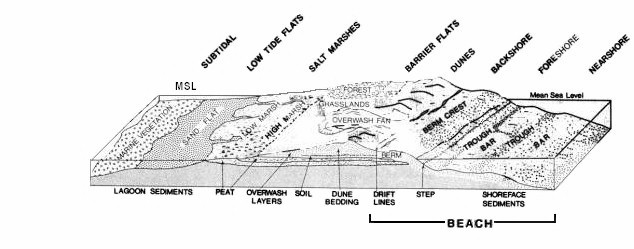Ocean
mean sea level

The origins of the word beach as a noun.
From the 1530s, "loose, water-worn pebbles of the seashore," probably from
Old English bæce, bece "stream," from Proto-Germanic *bakiz.
Later extended to loose, pebbly shores (1590s), and in dialect around Sussex and Kent beach still has the meaning "pebbles worn by the waves."
The French word, grève shows the same evolution.
| Bayside | Ocean |
|
mean sea level |

|
|
| inland | sand | seaward |
A view of the Atlantic Ocean from a protected Florida Atlantic Beach dune covered in Sea Oats, Uniola paniculata.
sub-littoral |
Lower |
Upper |
Dune Crest |
Scrub oak / palm |
Marsh & Mangrove |
| Renilla reniformis | Emerita | Amphipoda | Uniola paniculata | gopherus polyphemus | Ostrea |
| Sea pansies | Mole Crabs | Amphipods | Sea Oats | Gopher tortoise | |
Feeding footage |
Feeding |
Burrows as keystones |
|||
| Other neighbors: | |||||
| whelk | |||||
Back dune profile behind the beach.

Beach ball first recorded 1940; beach bum first recorded 1950.